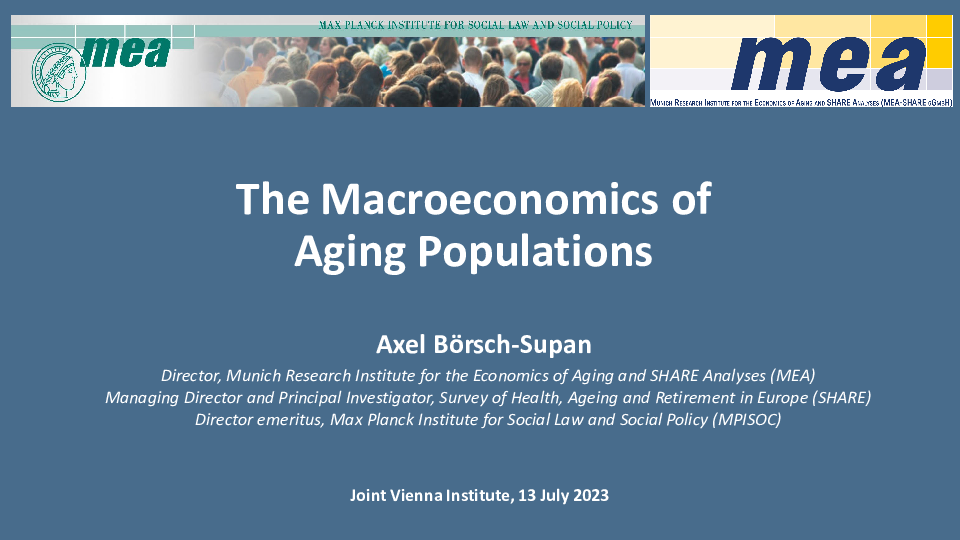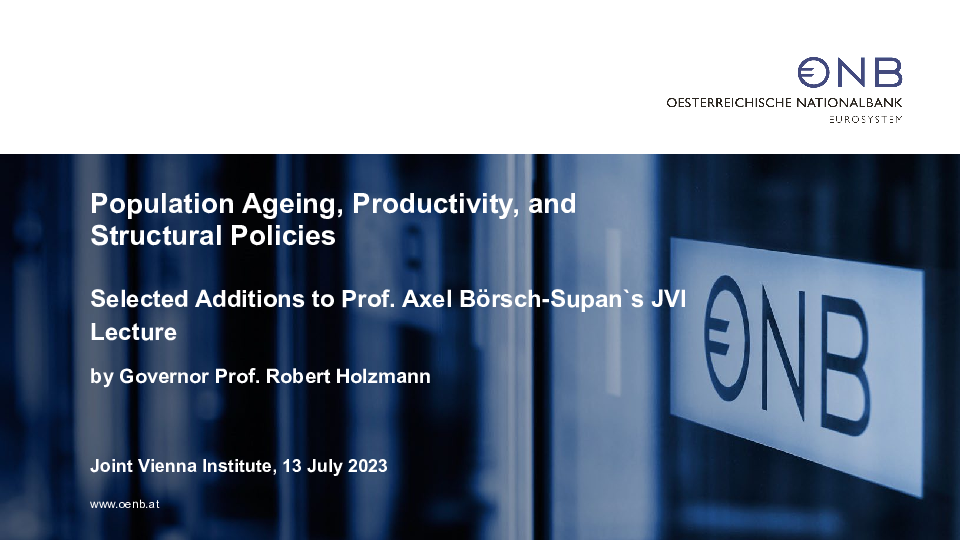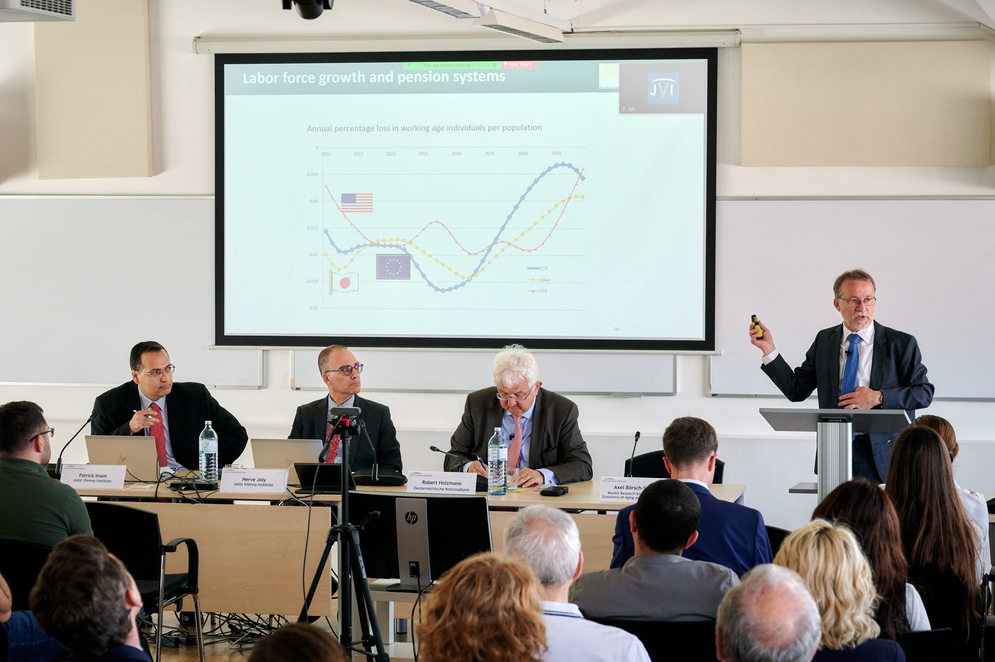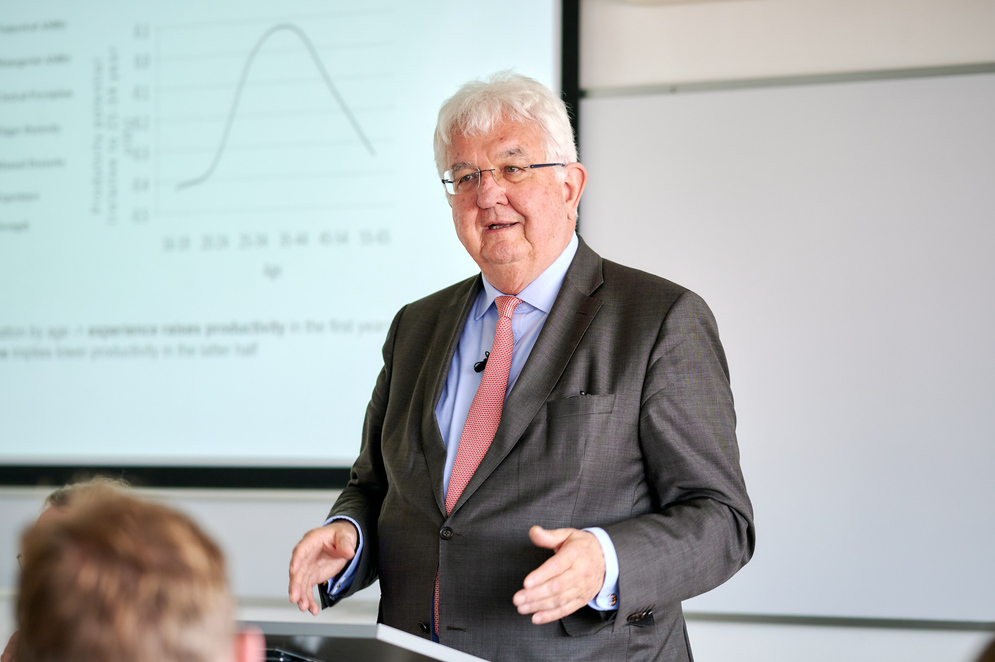The Macroeconomics of Aging Populations
Thursday, July 13, 2023 at 14:00-15:30 Vienna time (CEST)
Speaker
Prof. Dr. h.c. Axel Börsch-Supan, Ph.D., Director of the Munich Research Institute for the Economics of Aging and SHARE Analyses (MEA)
Discussant
Prof. Dr. Robert Holzmann, Governor, Oesterreichische Nationalbank (OeNB)
Moderator
Herve Joly, Director, Joint Vienna Institute
Population aging is not only a challenge for the social security systems, especially pensions, but also for the economy as a whole. Some claim that productivity growth will decline with an aging population, even though the evidence is unclear. Even more controversial is whether aging causes deflation or inflation. Finally, digitization may change our outlook on aging. While some think that the combination of demographic change, climate change, and digitization is the perfect storm for the world economy, others argue that their concomitance brings opportunities, at least to some extent. Population decline, like the one observed in many countries in Central, Eastern, and Southeastern Europe (CESEE), adds another layer of complexity to the macroeconomics of aging populations. For instance, population shrinking aggravates the aging-induced shortage of labor, while its impact on the total dependency burden is less clear, unlike that of aging.
Against this background, Professor Börsch-Supan illustrated in his presentation the different challenges faced by countries with aging populations (such as many advanced and emerging economies) and those with aging and shrinking populations (such as many CESEE countries). The key message of the presentation was that these demographic trends will have massive effects on the economy and the main effect runs through labor markets and the pension systems.
According to the projected changes in demographic indicators in CESEE, Professor Börsch-Supan stressed that between 2020 and 2050, average birth rates are expected to decline, life expectancy at birth will rise, and the old-age dependency ratio will increase sharply. This implies that by 2050, those aged 65 and above will correspond to nearly half of the working-age population (i.e., those between 15 and 64 years of age). Moreover, all countries, except for Türkiye, will have shrinking populations.
Based on a basic production function approach, the analysis suggests that these demographic trends in the CESEE region are likely to result in a decrease in GDP per capita. The primary reason for this is the expected reduction in labor input per capita. These effects might be further exacerbated by negative incentives arising from potential increases in taxes and social security contributions. To counteract the decline in the labor force, Professor Börsch-Supan stressed the urgency of implementing appropriate pension reforms. This includes aligning the effective retirement age more closely with the statutory one and, when necessary, raising the retirement age as life expectancy increases. He pointed out that, on average, individuals need to work for approximately two years to finance one year of retirement. With an increase in life expectancy by, say, three years, he argued that the effective retirement age should be raised by two years accordingly to ensure sustainability.
It is uncertain whether capital input and productivity will decline in an aging society. Professor Börsch-Supan concluded that it is unlikely that capital can fully substitute for the shrinking labor force in CESEE. One reason for this is the comparatively low savings rates in the region, which limit the potential for increased capital investment. Additionally, the presence of relatively shallow domestic capital markets plays a role, leading to a limited role for funded pension systems, which might have otherwise contributed to increased capital accumulation.
As regards productivity, Professor Börsch-Supan pointed to micro-level evidence according to which productivity can actually increase at higher ages. This is attributed to the accumulation of experience and established networks, which could compensate for any decline in physical strength and cognition that occurs with age. The impact of age on productivity appears to vary depending on the type of profession. Routine work might experience a decrease in productivity, while non-routine and advanced specialist work could see an increase. However, the macro evidence is less positive: Countries with a high old-age dependency ratio have lower total factor productivity. Causes are seen in less entrepreneurship and the crowding-out effects of high pension expenditures on spending for education, innovation and infrastructure. To bolster productivity, he therefore emphasized the critical role of sufficient government spending in areas like education, innovation (including digitization), and infrastructure. Digitization may initially pose challenges due to the need for technological adaptation and skill development, but it has the potential to create new job opportunities and compensate for the loss in labor supply resulting from population aging.
In the subsequent discussion, Governor Holzmann emphasized that labor productivity is influenced by various factors related to the competencies of different age cohorts and to broader economic trends. Younger generations now receive overall more years of schooling, which can lead to productivity increases as they enter the workforce with enhanced skills and knowledge. Medical advancements, such as performing more efficient surgeries reducing the period of convalescence, while typically poorly measured in the statistics, can also positively impact productivity. On the other hand, consumption patterns are likely to change in an aging society. People may consume more from sectors that are less productive, like cultural activities. Referring to a two-sector economy with one high-productivity sector and another less productive sector, a shift in activities/income toward the less productive sector could result in an overall decline in aggregate productivity growth. Governor Holzmann also stressed that addressing labor shortages involves more than just increasing the retirement age. It also requires focusing on “qualitative” labor force participation, as individuals need to be healthy, educated, and motivated to remain productive contributors to the workforce.
Governor Holzmann also emphasized the impact of demographic trends on monetary policy, particularly focusing on the neutral rate of interest r*. This rate is a crucial indicator in addressing full employment and price stability objectives with monetary policy instruments. r* has been consistently declining and has approached zero. Although population aging may contribute to this decline, historical evidence indicates that the decrease in r* has been a secular trend, spanning centuries, and cannot be solely attributed to population aging. The challenge of a near-zero r* has prompted central banks to implement unconventional monetary policy measures to overcome the zero lower bound constraint. While these measures were necessary for stimulating the economy, they have also brought about economic distortions. Governor Holzmann thus underscored the importance of exploring ways to re-raise r*. They include increasing productivity through technological advancements, investing in green transition technologies to combat climate change with Schumpeterian creative destruction, and managing the size of the labor force by encouraging labor force participation and much later retirement.
The Q&A session centered on the following points. First, the presenters recognized the difficulty of determining the impact of these demographic trends on inflation. While lower aggregate demand might lead to a decline in prices, skilled labor shortages and increased social security expenses could counterbalance this effect. Second, distributional issues such as the unequal distribution of inheritances were highlighted as significant concerns in aging societies. Structural reforms could disproportionately impact poorer individuals, emphasizing the importance of incorporating distributional measures alongside pension reforms. Third, the speakers discussed the challenges faced by CESEE countries with comparatively low replacement rates and savings. They emphasized again aligning the pension system with demographic parameters, such as adjusting retirement age according to life expectancy, while implementing additional measures to ensure higher replacement rates for lower-income individuals. Lastly, the importance of addressing informal employment in labor markets was highlighted, especially in raising social security contributions. However, experience from Latin American economies has shown that reducing informality requires a well-balanced approach, incorporating both controls and incentives to achieve meaningful results.
Markus Eller, Senior Economist, JVI

















